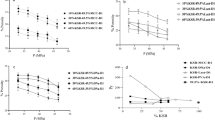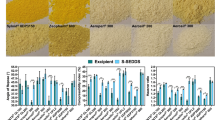Abstract
Objective
Proposed study was aimed to formulate and evaluate atorvastatin trihydrate calcium porous tablet.
Methods
Since atorvastatin trihydrate calcium is highly unstable drug and is immensely susceptible to hydrolysis and oxidation process, sublimation technique is taken into account for preparing porous tablet by using direct compression technique. Excipient screening and pre-formulation study was conducted to evaluate the presence of drug-excipient compatibility. Formulation was optimised using central composite design (CCD) and optimized batch was further characterised by scanning electron microscopy (SEM) for identification of surface topography. Optimized formulation was also characterised with respect to FTIR, TGA analysis, compression analysis, in vitro drug release studies and stability studies.
Results
Hardness, friability, disintegration time and drug content of optimized porous tablets were found to be 3.46 kg/cm2, 0.92%, 7.23 s and 97.00%, respectively. Compression analysis showed optimized formulation powder is soft and plastic in nature. Tensile strength studies revealed that the tensile strength increases with increase in compression pressure. SEM studies confirmed the presence of number of pores with less than 10 μm pore size. FTIR and TGA studies confirmed that there is no change in chemical structure of drug even in porous tablet. Prepared porous tablets released 85.06 ± 15.55% of drug in 25 min whereas immediate release marketed tablets and pure drug released only 59.13 ± 4.78% and 11.36 ± 2.90% of drug in a same time. The release of proposed dosage form was substantially greater than the marketed product. Preliminary profile of stability studies did not show any significant change (p > 0.05) in the results after 90 days.
Conclusion
Porous tablets improved release rate which confirmed that this approach may be useful to enhance the dissolution rate of atorvastatin trihydrate calcium.












Similar content being viewed by others
References
Cosijns A, Vervaet C, Luyten J, Mullens S, Siepmann F, van Hoorebeke L, et al. Porous hydroxyapatite tablets as carriers for low-dosed drugs. Eur J Pharm Biopharm. 2007;67(2):498–506.
Ahjel SW, Lupuleasa D. Enhancement of solubility and dissolution rate of different forms of atorvastatin calcium in direct compression tablet formulas. Farmacia. 2009;57(3):290–300.
Rodde MS, Divase GT, Devkar TB, Tekade AR. Solubility and bioavailability enhancement of poorly aqueous soluble atorvastatin: in vitro, ex vivo, and in vivo studies. Biomed Res Int. 2014;2014(463895):11.
Geethalakshmi A, Divya V, Mahalingan K. Enhancement of solubility and dissolution rate of atorvastatin calcium by co-solvent evaporation. World J Pharm Pharm Sci. 2013;2(5):3790–806.
Wicaksono Y, Wisudyaningsih B, Siswoyo TA. Enhancement of solubility and dissolution rate of atorvastatin calcium by co-crystallization. Trop J Pharm Res. 2017;16(7):1497–502.
Sharma Y, Kumar K, Padhy SK. Formulation and evaluation of atorvastatin calcium niosomes. Int J Life Sci Scienti Res. 2016;2(4):462–5.
Bora D, Borude P, Bhise K. Formulation and evaluation of self microemulsifying drug delivery systems of low solubility drug for enhanced solubility and dissolution. Asian J Biomed Pharm Sci. 2012;2(15):7–14.
Ajmeral A, Deshpande S, Kharadi S, et al. Dissolution rate enhancement of atorvastatin, fenofibrate and ezetimibe by inclusion complex with β-cyclodextrin. Asian J Pharm Clin Res. 2012;5(4):73–6.
Kulkarni MC, Kolhe SV. Formulation development and evaluation of atorvastatin calcium tablets using co-processed excipients. Int J Pharm Sci Rev Res. 2016;36(1):217–22.
Gubbi SR, Jarag R. Formulation and characterization of atorvastatin calcium liquisolid compacts. Asian J Pharm Sci. 2010;5(2):50–60.
Chandiran IS, Anandakirouchenane E. Enhancement of solubility of atorvastatin calcium by nanosuspension technique. Int J Biopharm. 2014;5(3):214–7.
Hasson KJ. Enhancement of atorvastatin tablet dissolution using acid medium. Iraqi J Pharm Sci. 2010;19(1):82–5.
Maniya NH, Patel SR, Murthy ZVP. Drug delivery with porous silicon films, microparticles and nanoparticles. Rev Adv Mater Sci. 2016;44:257–72.
Markl D, Wang P, Ridgway C, Karttunen AP, Chakraborty M, Bawuah P, et al. Characterization of the pore structure of functionalized calcium carbonate tablets by terahertz time-domain spectroscopy and X-ray computed microtomography. J Pharm Sci. 2017;106:1586–95.
Zhou M, Shen L, Lin X, Hong Y, Feng Y. Design and pharmaceutical applications of porous particles. RSC Adv. 2017;7:39490–501.
Sharma S, Sher P, Badve S, et al. Adsorption of meloxicam on porous calcium silicate: characterization and tablet formulation. AAPSPharmSciTech. 2005;6(4):E618–25.
Ishikawa T, Watanabe Y, Utoguchi N, et al. Preparation and evaluation of tablets rapidly disintegrating in saliva containing bitter-taste-masked granules by the compression method. Chem Pharm Bull. 1999;47(10):1451–4.
Koizumi K, Watanabe Y, Morita K, Utoguchi N, Matsumoto M. New method of preparing high-porosity rapidly saliva soluble compressed tablets using mannitol with camphor, a subliming material. Int J Pharm. 1997;152(1):127–31.
Singh SS, Verma R, Kumar L. Porous oral drug delivery system—tablets. Pharm Chem J. 2018. 52(6):553–61.
Porosity and its influence on pharmaceutical tablet dissolution profiles, 2017. Available at: https://www.azom.com/article.aspx? ArticleID=13574. Accessed on May 28, 2018.
Quodbach J, Kleinebudde P. A critical review on tablet disintegration. Pharm Dev Technol. 2016;21(6):763–74.
Podczeck F. Methods for the practical determination of the mechanical strength of tablets—from empiricism to science. Int J Pharm. 2012;436:214–32.
Thoorens G, Krier F, Leclercq B, Carlin B, Evrard B. Microcrystalline cellulose, a direct compression binder in a quality by design environment—a review. Int J Pharm. 2014;473:64–72.
Hasegawa M. Direct compression: microcrystalline cellulose grade 12 versus classic grade 102. Pharm Technol. 2002;26:50–60.
Estibeiro AL, Harmalkar D, Godinho S, et al. Lacidipine porous tablets: formulation and in vitro characterization. Lat Am J Pharm. 2018;37:1764–71.
Shirsand SB, Suresh S, Kusumdevi V, Swamy PV. Formulation design and optimization of fast dissolving clonazepam tablets by sublimation method. Indian J Pharm Sci. 2011;73:491–6.
Jeevanandham S, Dhachinamoorthi D, Chandra Sekhar KB, Muthukumaran M, Sriram N, Joysaruby J. Formulation and evaluation of naproxen sodium orodispersible tablets—a sublimation technique. Asian J Pharm. 2010;Jan-Mar;4:48–51.
Elbary AA, Ali AA, Aboud HM. Enhanced dissolution of meloxicam from orodispersible tablets prepared by different methods. Bull Faculty Pharm Cairo Univ. 2012;50:89–97.
Barnes TJ, Jarvis KL, Prestidge CA. Recent advances in porous silicon technology for drug delivery. Ther Deliv. 2013;4(7):811–23.
Srinivas NSK, Verma R, Kulyadi GP, et al. A quality by design approach on polymeric nanocarrier delivery of gefitinib: formulation, in vitro and in vivo characterization. Int J Nanomed. 2017;12:15–28.
Kumar L, Reddy MS, Managuli RS, et al. Full factorial design for optimization, development and validation of HPLC method to determine valsartan in nanoparticles. Saudi Pharm J. 2015;23(5):549–55.
Kumar L, Reddy MS, Shirodkar RK, Pai GK, Krishna VT, Verma R. Preparation and characterization of fluconazole vaginal films for the treatment of vaginal candidiasis. Indian J Pharm Sci. 2013;75(5):585–90.
Venugopal P, Gnanaprakash K, Kumar B, et al. Development of formulation and evaluation of ramipril porous tablet by sublimation technique. Int J Biopharm. 2014;5(4):258–64.
Kalyankar P, Panzade P, Lahoti S. Formulation design and optimization of orodispersible tablets of quetiapine fumarate by sublimation method. Indian J Pharm Sci. 2015;77(3):267–73.
Ibahim TM, Abdallah MH, El-Megrab NA, et al. Upgrading of dissolution and anti-hypertensive effect of carvedilol via two combined approaches: self-emulsification and liquisolid techniques. Drug Dev Ind Pharm. 2018;44(6):873–85.
Terakita A, Byrn SR. Structure and physical stability of hydrates and thermotropic mesophase of calcium benzoate. J Pharm Sci. 2006;95(5):1162–72.
Filho ROC, Franco PIBM, Conceição EC, Leles MIG. Stability studies on nifedipine tablets using thermogravimetry and differential scanning calorimetry. J Therm Anal Calorim. 2009;97:343–7.
Shete G, Puri V, Kumar L, Bansal AK. Solid state characterization of commercial crystalline and amorphous atorvastatin calcium samples. AAPS PharmSciTech. 2010;11(2):598–609.
Alakayleh F, Rashid I, Al-Omari MMH, et al. Compression profiles of different molecular weight. Powder Technol. 2016;299:107–18.
Persson AS, Ahmed H, Velaga S, Alderborn G. Powder compression properties of paracetamol, paracetamol hydrochloride, paracetamol cocrystals and coformers. J Pharm Sci. 2018;107(7):1920–7.
Paul S, Sun CC. Dependence of friability on tablet mechanical properties and a predictive approach for binary mixtures. Pharm Res. 2017;34:2901–9.
Shivanand P, Sprockel OL. Compaction behaviour of cellulose polymers. Powder Technol. 1992;69:177–84.
Nordström J, Klevan I, Alderborn G. A protocol for the classification of powder compression characteristics. Eur J Pharm Biopharm. 2012;80(1):209–16.
Krycer I, Pope DG, Hersey JA. An evaluation of the techniques employed to investigate powder compaction behaviour. Int J Pharm. 1982;12:113–34.
Heckel RW. Density-pressure relationship in powder compaction. Trans Metall Soc AIME. 1961;221:671–5.
Heckel RW. An analysis of powder compaction phenomena. Trans Metall Soc AIME. 1961;221:1001–8.
Chowhan ZT, Chow YP. Compression behaviour of pharmaceutical powders. Int J Pharm. 1980;5:139–48.
Andhariya JV, Choi S, Wang Y, Zou Y, Burgess DJ, Shen J. Accelerated in vitro release testing method for naltrexone loaded PLGA microspheres. Int J Pharm. 2017;520(1–2):79–85.
Gryczke A, Schminke S, Maniruzzaman M, Beck J, Douroumis D. Development and evaluation of orally disintegrating tablets (ODTs) containing ibuprofen granules prepared by hot melt extrusion. Colloid Surface Biointer. 2011;86:275–84.
Indian Pharmacopoeia, 2007. Volume 2. Government of India Ministry of Health & Family Welfare Ghaziabad: The Indian Pharmacopoeia Commission pp 751–52.
Kumar L, Reddy MS, Verma R, et al. Selection of cryoprotective agent for freeze drying of valsartan solid lipid nanoparticles. Lat Am J Pharm. 2016;35:483–9.
Silverstein RM, Webster FX. Infrared Spectroscopy. Spectrometric identification of organic compounds. 6th Ed. Singapore: John Wiley & Sons (Asia) Pte. Ltd. 2005;71–143.
Hu L, Gu D, Hu Q, Shi Y, Gao N. Investigation of solid dispersion of atorvastatin calcium in polyethylene glycol 6000 and polyvinylpyrrolidone. Trop J Pharm Res. 2014;13(6):835–42.
Mohylyuk V, Davtian L. Effect of diluent types and soluble diluents particle size on the dissolution profile of trimetazidine dihydrochloride and caffeine from kollidon SR matrix tablets. Int J Pharm Tech Res. 2015;8(6):147–55.
Khan MS, Vishakante GD, Bathool A. Preparation and evaluation of sodium alginate porous dosage form as carriers for low dosed active pharmaceutical ingredients. Turk J Pharm Sci. 2012;9(2):183–98.
Patil BS, Rao NGR. Formulation and evaluation of fast dissolving tablets of granisetron hydrochloride by vacuum drying technique. Applied Pharm Sci. 2011;1(4):83–8.
Harshitha MS, Krishnan SK, Ahmed MG. Formulation and evaluation of fast dissolving tablets of nebivolol hydrochloride. Int J Appl Pharm Biolog Res. 2016;1(2):78–86.
Elkordy AA, Tan XN, Essa EA. Spironolactone release from liquisolid formulations prepared with Capryol™ 90, Solutol® HS-15 and Kollicoat® SR 30 D as non-volatile liquid vehicles. Eur J Pharm Biopharm. 2013;83(2):203–23.
Atorvastatin Tablets, Indian Pharmacopoeia. Government of India Ministry of Health & Family Welfare. 2nd ed. The Indian Pharmacopoeia Commission: Ghaziabad; 2007. p. 751.
Roberts RJ, Rowe RC. The compaction of pharmaceutical and other materials—a pragmatic approach. Chem Eng Sci. 1987;42(4):903–11.
Atorvastatin calcium trihydrate. European Pharmacopoeia. 8th Edition. Council of Europe. pp. 1598–1600. Available from: https://wenku.baidu.com/view/35a9708f9ec3d5bbfd0a74f3.html?re=view. Accessed on 3rd May 2019.
Atorvastatin calcium trihydrate. PubChem. NIH US National Library of Medicine. Available from: https://pubchem.ncbi.nlm.nih.gov/compound/67019418. Accessed on 3rd May 2019.
Kim MS, Jin SJ, Kim JS, Park HJ, Song HS, Neubert RHH, et al. Preparation, characterization and in vivo evaluation of amorphous atorvastatin calcium nanoparticles using supercritical antisolvent (SAS) process. Eur J Pharm Biopharm. 2008;69:454–65.
Pathan IB, Shingare PR, Kurumkar P. Formulation design and optimization of novel mouth dissolving tablets for venlafaxine hydrochloride using sublimation technique. J Pharm Res. 2013;6:593–8.
Waiver of in vivo bioavailability and bioequivalence studies for immediate-release solid oral dosage forms based on biopharmaceutics classification system – Guidance for Industry, U.S. Department of health and human services. Food and Drug Administration (FDA), Centre for Drug Evaluation and Research (CDER), December 2017. Available from: https://www.fda.gov/downloads/Drugs/Guidances/ucm070246.pdf. Accessed on 20th June 2018.
Acknowledgements
The authors are thankful to Dr. Reddy Laboratories, Hyderabad, for providing atorvastatin trihydrate calcium as a gift sample. Authors gratefully acknowledge the help of Dr. Praveen Khullar, Mr. D. Saravanan and Dr. Prakash Muthudoss, Sanofi-Synthelabo (India) Pvt. Ltd., Verna, Goa, for thermogravimetric analysis of samples. Authors are thankful to Flamingo Pharmaceutical Ltd., Mumbai, for Karl Fisher Titrimetry study. Authors are also thankful to Manipal College of Pharmaceutical Sciences, Manipal Academy of Higher Education and Goa College of Pharmacy for providing the infrastructural facilities to complete this work.
Author information
Authors and Affiliations
Corresponding author
Ethics declarations
Conflict of Interest
The authors declare that there is no conflict of interest.
Additional information
Publisher’s Note
Springer Nature remains neutral with regard to jurisdictional claims in published maps and institutional affiliations.
Rights and permissions
About this article
Cite this article
Singh, S.Y., Salwa, Shirodkar, R.K. et al. Enhancement in Dissolution Rate of Atorvastatin Trihydrate Calcium by Formulating Its Porous Tablet Using Sublimation Technique. J Pharm Innov 15, 498–520 (2020). https://doi.org/10.1007/s12247-019-09397-1
Published:
Issue Date:
DOI: https://doi.org/10.1007/s12247-019-09397-1




